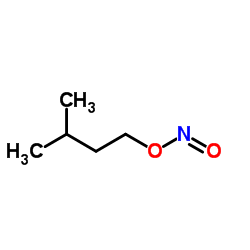Pentobarbital-like discriminative stimulus properties of halothane, 1,1,1-trichloroethane, isoamyl nitrite, flurothyl and oxazepam in mice.
D C Rees, J S Knisely, R L Balster, S Jordan, T J Breen
文献索引:J. Pharmacol. Exp. Ther. 241(2) , 507-15, (1987)
全文:HTML全文
摘要
Volatile inhalants represent a diverse group of chemicals which pose a public health problem because of their abuse potential and neurobehavioral toxicity. Although relatively little is known about their pharmacology, they share certain pharmacological properties with classic central nervous system depressants. Drug discrimination procedures were used to compare the effects produced by pentobarbital (PB), oxazepam and several inhalants. Mice were trained to discriminate PB from saline injections in a two-lever operant task. Stimulus generalization was examined after 20-min inhalation exposures to halothane (500-8000 ppm), 1,1,1-trichloroethane (500-12000 ppm), isoamyl nitrite (150-1050 ppm), flurothyl (562-1300 ppm) and injections of oxazepam (0.1-20 mg/kg). Halothane, 1,1,1-trichloroethane and oxazepam produced discriminative stimulus effects similar to those produced by PB. Isoamyl nitrite and flurothyl, while decreasing rates of responding, were not consistently generalized from PB. Differences are apparent in the PB-like discriminative effects of inhalants. Toluene, as shown in a previous study, as well as halothane and 1,1,1-trichloroethane have PB-like discriminative effects which are also shared by oxazepam and may be another common effect of central nervous system depressants. Other chemicals, like isoamyl nitrite and flurothyl, are representative of qualitatively different classes of behaviorally active inhalants.
相关化合物
| 结构式 | 名称/CAS号 | 分子式 | 全部文献 |
|---|---|---|---|
 |
亚硝酸异戊酯
CAS:110-46-3 |
C5H11NO2 |
|
Poly-S-nitrosated human albumin enhances the antitumor and a...
2015-02-01 [Cancer Sci. 106(2) , 194-200, (2015)] |
|
Tuning of poly-S-nitrosated human serum albumin as superior ...
2014-07-01 [J. Pharm. Sci. 103(7) , 2184-8, (2014)] |
|
Molecular mechanisms of nitrovasodilator bioactivation.
1991-01-01 [Basic Res. Cardiol. 86 , 37-50, (1991)] |
|
Electron paramagnetic resonance and spin trapping study of r...
1990-01-01 [Free Radic. Res. Commun. 10(1-2) , 47-56, (1990)] |
|
Synthesis of peroxynitrite in a two-phase system using isoam...
1996-05-01 [Anal. Biochem. 236(2) , 242-9, (1996)] |